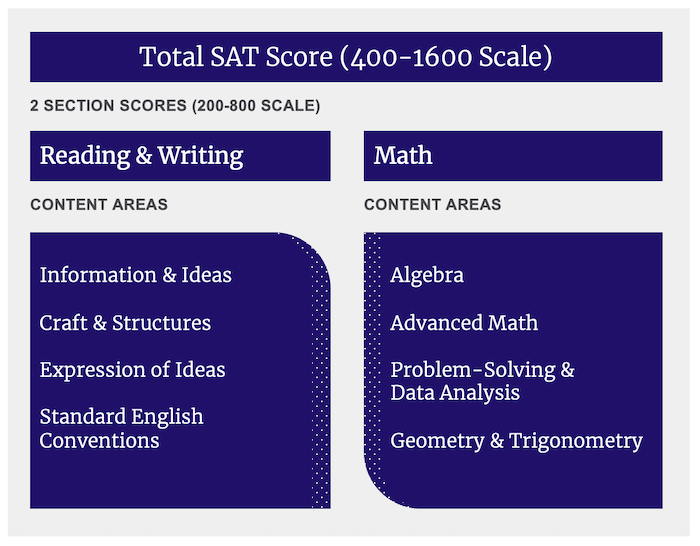What Is a Good SAT Score? (2025)
- A good SAT score is generally considered to be 1210 or higher, which would put you in the top 25% of all test takers.
- In 2023, the national average score earned on the SAT was 1028, and a “perfect” score on the SAT is the maximum score of 1600.
- Every college and university has its own unique SAT score range which should be consulted when determining what a “good” score is for you.
- Your SAT score does not determine if a college will accept you, but a high score can make you a more competitive applicant.
A good SAT score is subjective, ultimately depending on what schools you are applying to. However, earning a high SAT score will make you stand out to college admissions officers and can increase your chances of getting a college scholarship. Learn about current SAT scores for top universities and how the SAT scoring system works so you can understand what a good SAT score is and set your exam goals.
TABLE OF CONTENTS
- SAT Scores for Ivy League Schools
- SAT Scores for Top Universities in the U.S.
- SAT Scores for Top Liberal Arts Colleges in the U.S.
- How does SAT scoring work?
- SAT Score Ranges & Percentiles
- How to Compare Scores on the Digital SAT & Paper-and-Pencil SAT
- Does my SAT score determine which college will accept me?
- How to Improve Your SAT Score
- SAT Preview Quiz
- SAT/ACT Score Conversion Calculator
SAT Scores for Ivy League Schools
The eight private universities that comprise the Ivy League are some of the most competitive universities in the U.S. Earning a good SAT score is an important factor in gaining acceptance into an Ivy League School. A competitive score for any of the Ivy League schools is a score of about 1560 (out of 1600). In the table below, we showcase the SAT score ranges for Ivy League Schools in 2023.
| IVY LEAGUE SCHOOL | SAT SCORE RANGE | ACCEPTANCE RATE |
| Brown University | 1470-1550 | 6% |
| Columbia University | 1500-1560 | 4% |
| Cornell University | 1470-1550 | 7% |
| Dartmouth College | 1480-1560 | 6% |
| Harvard University | 1490-1580 | 3% |
| Princeton University | 1470-1560 | 4% |
| University of Pennsylvania | 1480-1570 | 7% |
| Yale University | 1470-1560 | 5% |
Sources: College Board BigFuture & U.S. News
SAT Scores for Top Universities in the U.S
In addition to the Ivy League SAT scores listed above, you may be wondering about SAT scores needed for other top universities in the U.S. Read on for information about SAT scores needed for these top universities.
SAT Score Needed for Stanford University
Students who gain acceptance into Stanford University have an SAT score between 1500 and 1570. Stanford is a university in Palo Alto, CA that is influenced by the innovative environment provided by neighboring Silicon Valley. Stanford has under 8,000 undergraduate students and a 6:1 student-to-faculty ratio, giving it a small, liberal arts college feel.
SAT Score Needed for Duke University
Students who gain acceptance into Duke University have an SAT score between 1510 and 1560. Duke is the 5th largest research university in the United States based on research funding, and over half of Duke undergraduates complete faculty-mentored research projects. This Durham, NC school encourages students to take a variety of courses, and students can choose from a long list of majors and minors or even, in some circumstances, design their own degree program that fits their interests.
SAT Score Needed for John Hopkins University
Students who gain acceptance into Johns Hopkins University have an SAT score between 1490 and 1550. Johns Hopkins, located in downtown Baltimore, is a research-based university with an emphasis on academic freedom. That means that undergraduates aren’t required to take any set core classes; instead, Johns Hopkins encourages students to take interdisciplinary courses and explore a wide range of topics. Additionally, many internships and study abroad opportunities are available to undergraduates—over a third of students complete some sort of international experience and 85% complete at least one internship before they graduate.
SAT Score Needed for NYU
Students who gain acceptance into New York University (NYU) have an SAT score between 1470 and 1560. NYU is a private research university with campuses in New York, Abu Dhabi, and Shanghai. The university comprises 20 schools and colleges and has a student body of over 50,000 students. The renowned Tisch School of the Arts offers a wide range of undergraduate and graduate programs in acting, dance, dramatic writing, film, television, and more. Former Tisch students include acclaimed directors Martin Scorsese and Spike Lee.
SAT Score Needed for MIT
Students who gain acceptance into the Massachusetts Institute of Technology (MIT) have an SAT score between 1520 and 1570. MIT, a science and technology-based university in Cambridge, Massachusetts, was founded in 1861 for the purpose of advancing the Industrial Revolution. Today, the school is known for its strength in science and engineering. Over 60% of MIT students enroll in the School of Engineering, and nearly 30% complete a major in the School of Science. 85% of undergraduate students participate in faculty-led research.
SAT Score Needed for the University of Chicago
Students who gain acceptance into the University of Chicago have an SAT score between 1510 and 1560. Undergraduates at the University of Chicago begin their education with a core curriculum akin to what you’d find at a liberal arts university. The University of Chicago aims to teach students how—not what—to think, so students take a set of core classes designed to prepare them to explore complex ideas and debate with other students and faculty members.
SAT Scores for Top Liberal Arts Colleges in the U.S.
The best liberal arts colleges are just as competitive as the best universities. Keep in mind that none of these colleges have an SAT minimum score cutoff, and your SAT score is far from the only factor considered in your application. Each of these schools views your application holistically, meaning that other factors such as GPA, extracurriculars, and who you are as a person will also come into play. Here are the SAT scores needed for some of the top liberal arts colleges in the U.S.:
SAT Score Needed for Williams College
Students who gain acceptance into Williams College have an SAT score between 1490 and 1550. Williams College was founded in 1793 in Williams, Massachusetts. It has three academic branches: arts and humanities, social sciences, and science and mathematics. Within these three branches, there are 36 majors students can choose from. Instead of a minor, students at Williams chose a “concentration,” which is a grouping of classes spanning multiple disciplines centered on a broad topic such as Maritime Studies or Public Health.
SAT Score Needed for Amherst College
Students who gain acceptance into Amherst College have an SAT score between 1450 and 1550. Amherst College in Amherst, Massachusetts doesn’t have any core requirements, which allows students to completely create their own curriculum. There are 40 total majors offered at Amherst in the arts, sciences, social studies, and humanities. Thanks to small class sizes—the average is 19 students per class—and a 7:1 student-to-faculty ratio, students at Amherst have lots of opportunities for discussion with classmates and faculty members.
SAT Score Needed for Pomona College
Students who gain acceptance into Pomona College have an SAT score between 1480 and 1540. Pomona College is located about 30 miles from Los Angeles in Claremont, CA. It’s one of the Claremont Colleges, a consortium of five undergraduate colleges and 2 graduate schools within several blocks of each other that share a library and other resources. Students at Pomona are encouraged to participate in research, and small class sizes facilitate seminar-based learning. In an effort to encourage students to study abroad, Pomona charges the same tuition for semesters abroad as it does for semesters at the main campus.
SAT Score Needed for Swarthmore College
Students who gain acceptance into Swarthmore College have an SAT score between 1455 and 1540. Swarthmore is located in Swarthmore, Pennsylvania, and is a somewhat unique liberal arts school for a couple of reasons. First, Swarthmore wants students to explore their interests and see what Swarthmore has to offer. To encourage this, first-semester classes are essentially pass/fail—the classes you take go on your transcript, but your grades don’t. Second, you can study engineering at Swarthmore, whereas liberal arts colleges usually don’t have pre-professional programs.
SAT Score Needed for Wellesley College
Students who gain acceptance into Wellesley College have an SAT score between 1440 and 1540. Wellesley is a women’s college in the educational hub of Wellesley, MA. Located not far from Babson College, MIT, Brandeis University, and Olin College of Engineering, a Wellesley education includes opportunities to study at—and even get a joint degree with—any of the aforementioned schools.
SAT Score Needed for Bowdoin College
Students who gain acceptance into Bowdoin College have an SAT score between 1340 and 1520. Students at Bowdoin College in Brunswick, Maine, begin their studies with foundational courses in each of the following basic disciplines: mathematics, computational or statistical reasoning, inquiry in the natural sciences, exploring social differences, international perspective, and visual and performing arts. Students declare majors as sophomores. The admissions process at Bowdoin is unique in that most applicants aren’t required to submit GPAs or standardized test scores. They can submit scores if they wish, but Bowdoin hasn’t required applicants to submit scores since 1969.
How does SAT scoring work?
Now that you’ve seen what a good SAT score is at top universities, we’ll break down how the SAT scoring system works. SAT scoring is based on a 1600-point scale, with two sections—Math and Reading and Writing—scored between 200 and 800. There is no penalty for wrong answers, so your raw score is the sum of the number of questions you answer correctly. SAT raw scores are converted to scaled scores, which are used to determine percentile ranks. The percentile indicates how well you did compared to other test takers. For example, if you score in the 72nd percentile, you did better than 72% of SAT test takers. This process ensures that your score is not affected by different forms of the test or other students’ ability levels. This scaled score is what you will see when you get your scores.

SAT Scoring Factors
The SAT is scored on a 200 to 800 scale in each section in 10-point increments. The two sections (Reading and Writing and Math) will have scores provided separately. This relatively small scale means that small improvements in your score can make a big difference in your percentile rank. For example, a 10-point increase in your score could boost your percentile rank by several points.
SAT Score Ranges & Percentiles
Below are SAT scoring ranges and percentiles from 2023.
How to Compare Scores on the Digital SAT & Paper-and-Pencil SAT
Beginning in the spring of 2024, the SAT will no longer be a pencil-and-paper exam. With the exception of certain student accommodations, all students will take the Digital SAT on a computer. Despite the changes to the SAT, the exam will continue to be scored on a 1600-point scale like its predecessor. Your overall Digital SAT score will range from 400–1600 and is calculated by adding your two section scores together.
[ READ NEXT: How to Prepare for the Digital SAT ]
Scoring on the Adaptive Digital SAT
The new SAT is adaptive. How well you do on your first module determines the questions you see in the second. This is often called a multi-staged test. Doing well on the first module, also known as the routing module, will send you to a higher-difficulty second module. This will give you a chance to earn the very top scores for a section (either Reading and Writing or Math).
Bear in mind that even if you are routed to an easier second module, you can still earn a competitive score on the SAT. Don’t spend time trying to figure out which difficulty level you were routed to; this will only waste your brainpower and time. Your focus should be to do your best on every question, regardless of the module. While their exact formula is proprietary, your total SAT score is based on how you do on both modules of Reading and Writing and both modules of Math. There is very likely an overlapping range of scores possible for students routed to the easier or harder second module.
Does my SAT score determine which college will accept me?
Your SAT score does not determine which college will accept you, but a good SAT score can help differentiate your application, even if the SAT is optional at the school you are applying to. Whether or not you are admitted to a college program (and whether or not you receive scholarship money) can depend on several factors. In addition to focusing on achieving the best SAT score possible for you, you should also work on obtaining the best GPA possible, writing a spectacular personal statement, taking a challenging course load, and rounding out your application with extracurriculars.
Test-Optional College Admissions
Some colleges have decided to make SAT test scores optional as part of their application requirements. This may sound like a good idea, but if you are looking to have your application stand out, a good SAT score is still one of the best ways to do that. Just because a school has decided to allow applicants to exclude SAT test scores does not mean other applicants are not continuing to submit SAT scores when applying.
How to Improve Your SAT Score
Improving your SAT score by even ten points can increase your chances of getting into your dream school. Kaplan offers a wide range of free prep resources to help you succeed on the SAT, including:
- SAT Question of the Day: Raise your SAT score with free daily practice questions delivered straight to your inbox!
- Free SAT Practice Test: See how you would score with an SAT practice test and get a detailed report of your strengths and weaknesses.
- SAT Study Plans: Whether you are studying for three months or have just one month before test day, we have an SAT study plan to help you stay organized.
- SAT On Demand Free Trial: Try Kaplan’s SAT Prep On Demand Course free for seven days and see how our experts can help you maximize your SAT score.
SAT Preview Quiz
Find out how you would do on the SAT by practicing with our quick quiz!
SAT/ACT Score Conversion Calculator
Quickly convert your SAT score to an ACT score using our free calculator.
Written by Kaplan experts, reviewed by Heather Waite, Director of Content and Curriculum, Pre-College at Kaplan North America. Heather has taught thousands of students how to master the PSAT, ACT, and SAT for over a decade. She holds a B.A. in Elementary Education from Indiana University.






